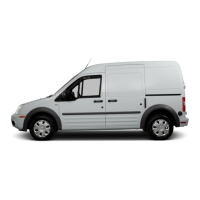Driver information Page: 18 Views in the display area Explains how to change the main display view and lists available views like Summary, Basic, Classic, Navigation, etc.
Rev counter Explains the rev counter dial, its red zone, and when to change gears or lift off the accelerator.
Fuel gauge Describes the digital and analogue fuel gauges and the arrow indicating the fuel tank flap side.
Digital fuel gauge Explains the digital fuel gauge and the arrow indicating the fuel tank flap side.
Analogue fuel gauge Explains the analogue fuel gauge and the arrow indicating the fuel tank flap side.
Troubleshooting Provides troubleshooting steps for issues related to the fuel tank.
and Coolant Addresses the red warning lamp for coolant issues, indicating low level or system fault.
Fuel range display Explains the calculation of remaining distance based on fuel and driving style.
Convenience consumers Lists active convenience systems that affect energy consumption, showing guide values.
Service Provides information on the Service menu and related settings.
Service menu Explains that settings can be made in the Service menu depending on vehicle equipment.
Setting the time Guides on setting the time via digital or analogue instrument clusters and Infotainment system.
Exit menu Explains the Exit menu for adjusting function settings before leaving the vehicle.
Setting Explains how to change the sequence of displayed entries.
Vehicle settings menu Explains how the Infotainment system combines key vehicle systems for settings adjustment.
Driver Alert Introduces the Driver Alert system that detects driver tiredness and provides warnings.
Introduction Explains the Driver Alert system's purpose in detecting driver fatigue and issuing warnings.
Introduction Explains the Traffic Sign Recognition system's function using a camera to monitor traffic signs.
Error messages Lists error messages for Traffic Sign Recognition, such as initialisation phase or system fault.
Function limitations Lists system-related limitations for Traffic Sign Recognition, such as poor visibility or dirty camera.
Trailer mode Explains how trailer mode adjusts speed warning and traffic sign recognition for towing.
Safety Page: 44 General information Offers general advice on vehicle usage, including optional guards and preparation for trips and driving safety.
Driving abroad Advises on finding legal requirements and technical modifications for driving abroad.
Checks when filling up Provides instructions and warnings regarding work in the engine compartment and checks when filling up.
Sitting position Describes options for adjusting front seats and ensuring correct sitting position.
Introduction Introduces the section on adjusting front seats and emphasizes correct sitting position.
Number of seats States that the number of seats depends on configuration and equipment.
Retrofitting seats Discusses the possibility of retrofitting seats, requiring qualified workshops and specific anchor points.
Sitting position Refers to the start of the chapter for correct sitting position guidance.
Seat belts Introduces the section on seat belts, emphasizing regular checks and proper usage.
Introduction Introduces the importance of checking seat belt condition and using qualified workshops for replacements.
Troubleshooting Provides troubleshooting steps for seatbelt status indicator issues.
Fastening the seat belts Details steps for fastening seat belts before every trip, including seat and head restraint adjustment.
Twisted seat belt Explains how to deal with a twisted seat belt and when to contact a workshop.
Seat belt routing Refers to the start of the chapter for correct seat belt routing guidance.
Belt tensioners Describes belt tensioners activated by sensors during collisions to tighten seat belts.
Airbag system Introduces the airbag system and its components for occupant protection.
Introduction Explains that the airbag system provides additional chest and head protection, but is not a substitute for seat belts.
Airbag system Explains the manual deactivation of the front passenger airbag via a key-operated switch.
Indicator lamp Refers to the start of the chapter for information on indicator lamps.
Troubleshooting Provides troubleshooting steps for faults in the airbag and belt tensioner systems.
Side airbags Refers to the start of the chapter for information on side airbags.
Central airbag Refers to the start of the chapter for information on the central airbag.
Curtain airbags Refers to the start of the chapter for information on curtain airbags.
Introduction Explains how child seats reduce injury risk and emphasizes their use when transporting children.
Airbag sticker Refers to stickers providing key information about the front passenger front airbag.
Securing systems Refers to the start of the chapter for information on securing systems.
Transporting items Page: 260 Stowing loads Always observe legal requirements for transporting loads in the luggage compartment, on the floor, trailer, or roof carrier.
Stowing loads safely Provides guidelines for distributing loads evenly, stowing them forward, using fastening rings, and securing objects.
Bag hook Explains the use and limitations of bag hooks in the luggage compartment.
Fastening rings Advises observing the maximum load rating of the fastening rings.
Net partition Explains how to install and remove the net partition behind the front or second row of seats.
Installing Steps for installing the net partition behind the second row of seats.
Removing Steps for removing the net partition.
Installing Steps for installing the net partition behind the third row of seats.
Removing Steps for removing the net partition.
Adjustable partition Explains how the partition prevents objects from entering the passenger compartment and how to fit it.
Towing bracket Page: 268 Safety check. Details the safety checks to perform before hitching a trailer, ensuring the ball coupling is secured correctly.
Towing a trailer Introduces towing a trailer, covering technical equipment, driving considerations, and specific situations.
Introduction Introduces towing a trailer, covering technical equipment, driving considerations, and specific situations.
Driving with a trailer Provides advice on driving with a trailer, including headlamp adjustment and things to note.
Headlamp adjustment Explains how to adjust headlamps when towing a trailer to avoid blinding other road users.
Trailer stabilisation Explains the trailer stabilisation function, which detects and counter-steers to prevent snaking.
Fuel and emission control Page: 282 Fuel types and refuelling Introduces fuel types and refuelling procedures, including fuel cap location and information labels.
Fuel standards States that fuel must comply with specified standards, with workshop consultation for unavailable fuels.
Petrol Explains petrol types, RON, ethanol content (E5, E10), and quality effects on engine performance.
Diesel Advises using low sulphur or sulphur-free diesel to avoid engine and particulate filter damage.
Synthetic diesel fuels Defines synthetic diesel fuels (XTL) including GTL, BTL, and HVO, and their fuel standards.
Refuelling process Details the process of refuelling, including unlocking the tank flap and screw-on procedure.
Diesel ageing Explains the aging process of diesel fuel with high biodiesel content and its potential impact on the fuel system.
Troubleshooting Provides troubleshooting steps for irregular engine running and faults related to fuel quality.
Water in the diesel fuel Explains the yellow indicator lamp for water in diesel, advising immediate action and workshop checks.
Emission control Provides a checklist for emission-relevant components to ensure their longevity and proper function.
Checklist Lists points to observe for emission-relevant components to ensure proper function and longevity.
AdBlue Provides legal information, operating instructions, and warnings regarding AdBlue® usage.
Legal information States that technical modifications affecting emission control by AdBlue® are prohibited.
Information on AdBlue Explains AdBlue® consumption, distance to empty display, and limitations at low temperatures.
Refilling AdBlue Refers to the start of the chapter for instructions on refilling AdBlue® using a refill bottle or pump nozzle.
Preparing for refilling Details steps for preparing to refill AdBlue®, including parking the vehicle and opening the tank flap.
Particulate filter Refers to the start of the chapter for information on the particulate filter.
Diesel engines Explains the regeneration function of the particulate filter, including automatic regeneration.
Regeneration function Explains the process of burning soot in the particulate filter to prevent clogging, involving high temperatures and diesel injection.
Automatic regeneration Describes automatic regeneration of the particulate filter at high temperatures, advising against short trips.
Troubleshooting Provides troubleshooting steps for faults related to the SCR system, AdBlue® level, and particulate filter.
AdBlue level too low Explains the red warning lamp and message for a low AdBlue® level, indicating inability to restart the engine.
SCR system fault Addresses yellow/white indicator lamps and messages for SCR system faults or incorrect AdBlue® filling.
AdBlue level low Describes the yellow/white indicator lamps and messages for a low AdBlue® level, advising refilling.
Emissions-relevant fault Addresses the yellow indicator lamp for faults in emissions-relevant components, advising workshop checks.
Misfiring Explains the flashing yellow indicator lamp for misfiring, advising workshop checks.
If and when Page: 293 Vehicle tool kit Introduces the vehicle tool kit, its purpose for securing the vehicle during breakdowns, and safety precautions.
Contents of the vehicle toolkit Lists the components of the vehicle toolkit, including screwdriver, anti-theft wheel bolt adapter, towing eye, jack, and box spanner.
Stowage Refers to the start of the chapter for information on stowage locations of the vehicle toolkit and removable ball coupling.
Vehicle toolkit Explains the location of the vehicle toolkit in the luggage compartment and the removable ball head under the front passenger seat.
Removable ball head Describes the location of the removable ball head in a foam part under the front passenger seat.
Changing fuses Provides an overview of fuse locations and procedures for changing fuses, with warnings about electrical system safety.
Introduction States that a complete overview of fuse locations is not provided due to vehicle development and shared fuses.
Fuses in the dash panel Refers to the start of the chapter for instructions on opening the fuse box in the dash panel for left-hand and right-hand drive vehicles.
Changing a fuse Details the procedure for changing a fuse, including detecting a blown fuse and using plastic pliers.
Fuse types Lists different fuse types: standard flat blade, small flat blade, and large flat blade fuses.
Jump starting Provides instructions and warnings for jump starting a vehicle, emphasizing safety procedures.
Introduction Explains that tow-starting is not permitted and provides instructions for jump starting a vehicle with a discharged battery.
Starting the engine Explains how to start the engine of the vehicle providing assistance and the vehicle being jump-started.
Removing the jump leads Details the procedure for safely removing jump leads after starting the engine, including switching off lights and running the blower.
Towing Introduces towing, covering methods, limitations, and safety precautions.
Introduction Introduces towing, covering methods, limitations, and safety precautions.
Notes on towing Provides notes on towing, including use of turn signals, hazard warning lights, and situations where towing is not permitted.
Towing Explains towing methods with tow-rope or tow-bar, gearbox lubrication, and maximum speed/distance limits.
Pulling vehicle (front) Details the procedure for pulling a vehicle from the front, emphasizing gentle movements and clutch use.
Checking and refilling Page: 312 Changing fuses Provides an overview of fuse locations and procedures for changing fuses, with warnings about electrical system safety.
Fuses in the dash panel Refers to the start of the chapter for instructions on opening the fuse box in the dash panel for left-hand and right-hand drive vehicles.
Replacing blown fuses Details the procedure for replacing blown fuses, including detecting a blown fuse and using plastic pliers.
Fuse types Lists different fuse types: standard flat blade, small flat blade, and large flat blade fuses.
Engine oil Explains engine oil requirements, types, and the importance of correct oil for function and service life.
Introduction Explains engine oil requirements, types, and the importance of correct oil for function and service life.
Engine oil standards Advises using oils and fluids that meet designated specifications and viscosities, warning against damage from incorrect types.
Changing engine oil Refers to the start of the chapter for instructions on changing engine oil, emphasizing qualified workshops.
Engine oil consumption Explains engine oil consumption variations and the need for regular checks, especially for new vehicles and during demanding driving.
Troubleshooting Provides troubleshooting steps for engine oil related issues: pressure too low, level too high, or level too low.
Engine oil pressure too low Addresses the red warning lamp for low oil pressure, advising to stop the vehicle and seek expert assistance.
Engine oil level too high Addresses the yellow indicator lamp for high oil level, advising to stop the vehicle and seek expert assistance.
Coolant Provides safety notes and information on coolant, its properties, and environmental considerations.
Introduction Provides safety notes and information on coolant, its properties, and environmental considerations.
Coolant specification Refers to specifications for coolant, advising factory-filled mixture and limitations on additives.
Brake fluid Explains the importance of brake fluid, its properties, and the risks associated with water content and contamination.
Brake fluid specification Advises checking brake fluid specifications and using only manufacturer-standard or compliant fluids.
Brake fluid level Describes the brake fluid level indicator lamp and actions to take if the level is too low.
Brake fluid change Recommends changing brake fluid by a qualified workshop using only new, specified fluid.
12-volt vehicle battery Page: 325 Introduction Explains the 12-volt vehicle battery as part of the electrical system and emphasizes safety procedures for electrical work.
Troubleshooting Provides troubleshooting steps for 12-volt vehicle battery issues, including warning lamps and messages.
12-volt vehicle battery Addresses the yellow indicator lamp and messages for battery faults, recommending workshop checks or short drives for recharging.
General guide Provides a general guide to checking the electrolyte level of 12-volt vehicle batteries with a battery window.
Wheels and tyres Page: 330 Introduction Introduces tyre monitoring systems that warn the driver of low tyre pressures.
Reference pressure Defines reference pressure as cold tyre pressure with maximum load and its relation to the tyre pressure sticker.
Tyre pressure Refers to the start of the chapter for information on tyre pressure.
Checking the tyre pressure Provides guidelines for checking tyre pressure regularly, especially when tyres are cold or after adjustments.
Functional description Explains that the Tyre Pressure Loss Indicator uses ABS sensors to check tyre pressure and warns of loss.
Low tyre pressure Addresses the yellow indicator lamp and text message for low tyre pressure, advising to check and adjust pressure.
Introduction Highlights the importance of tyres, their dependence on pressure, driving style, handling, and fitting, recommending workshop services.
Tread depth Explains the importance of tread depth for driving situations and legally permissible minimums.
Tyre damage Refers to the start of the chapter for information on tyre damage.
New tyres Advises careful driving with new tyres due to reduced grip and braking effect, and emphasizes same-type tyre fitting.
Replacing tyres Recommends replacing tyres on an axle-by-axle basis and only using approved tyres.
Handling wheels and tyres Recommends having wheel changes done by a qualified workshop and provides advice on avoiding wheel damage.
Rotating wheels Recommends regular wheel rotation for even tyre wear and suggests workshop services for wheel changes.
All-terrain tyres Describes all-terrain tyres and their impact on driving properties, recommending winter or all-season tyres for winter conditions.
New tyres Advises careful driving with new tyres due to reduced grip and braking effect, and emphasizes same-type tyre fitting.
Replacing tyres Recommends replacing tyres on an axle-by-axle basis and only using approved tyres.
Snow chains Provides information on using snow chains, including legal requirements, speed limits, and tyre/wheel combinations.
Hubcaps Describes centre wheel trims, their removal and fitting, and warnings about unsuitable or incorrectly fitted hubcaps.
Centre wheel trim Describes centre wheel trims, their removal and fitting, and warnings about unsuitable or incorrectly fitted hubcaps.
Wheel cover Explains the purpose of wheel covers and warnings about fitting them correctly.
Wheel bolt caps States that wheel bolt caps protect wheel bolts and should be replaced after tyre changes.
Changing a wheel Refers to the start of the chapter for instructions on changing a wheel.
Introduction Explains the purpose of the jack and provides safety precautions for changing a wheel.
Removing the wheel Details the steps for removing a wheel, including loosening bolts and using the jack.
Jacking points Shows the jacking points on the vehicle and emphasizes using the correct ones.
Breakdown set Introduces the breakdown set for safely sealing tyre damage and provides usage instructions and warnings.
Introduction Introduces the breakdown set for safely sealing tyre damage and provides usage instructions and warnings.
Sealing a tyre Details the procedure for sealing a tyre using the breakdown set, including valve core removal and sealant injection.
Inflating the tyre Guides on inflating the tyre using the air compressor from the breakdown set, including pressure checks.
Maintenance Page: 361 Vehicle care Provides recommendations for cleaning and caring for individual vehicle components, emphasizing proper products and techniques.
Notes on vehicle care Offers notes on vehicle care, emphasizing following manufacturer instructions and avoiding harsh cleaning agents.
Windows, glass surfaces Provides instructions for cleaning windows and glass surfaces, including removing wax, ice, and dirt.
Sensors and camera lenses Advises on cleaning sensor and camera areas with soft cloths and solvent-free agents, avoiding high-pressure cleaners.
Paint Recommends careful treatment of paint surfaces, using mild soap solutions or cleaning clay for dirt removal.
Washing the vehicle Explains how washing the vehicle regularly prevents soiling effects and provides information on proper washing techniques.
Windows Details how to clean and dry windows using glass cleaner and a lint-free cloth.
Plastic parts Advises cleaning plastic parts with a damp cloth, using solvent-free cleaner for stubborn dirt.
Windscreen repairs Explains that electrical or electronic modules on the windscreen require replacement if damaged, potentially causing equipment malfunction.
Electromagnetic radiation Explains electromagnetic radiation from mobile phones and its potential health hazards, recommending distance from medical implants.
Using a telephone Advises using hands-free systems via Bluetooth for telephone functions and securing mobile phones.
Two-way radios Stresses observing legal regulations and obtaining approval for retrofitting two-way radio systems.
Customer information Provides information on stickers, safety certificates, fluids, and vehicle components.
Stickers and plates Explains the importance of factory-fitted stickers and plates for vehicle operation and safety.
Safety certificate Describes the safety certificate on the door pillar detailing compliance with safety standards.
Component protection Explains component protection for electronic components, requiring qualified workshops for installation.
REACH Provides information on the REACH regulation concerning chemical substances and responsible product handling.
Used batteries Emphasizes separate collection and recycling of used batteries, noting hazards of heavy metals and lithium batteries.
Declaration of conformity States that listed components comply with basic requirements and regulations, with details available online.
Scrapping Emphasizes observing safety requirements when scrapping vehicle components like airbags and belt tensioners.
Technical data Page: 404 Notes on technical data Explains that technical data applies to the basic model and may vary due to optional equipment or country.
Weight Provides values for kerb weight, load, and drawbar load, noting increases from additional equipment.
Explanation of the tables Explains abbreviations used in tables, such as MG for manual gearbox and AT for automatic transmission.
Performance figures States that performance figures are measured without equipment affecting performance and may vary due to registration/taxation.
Petrol engines Provides engine overview, weight ratings, and axle loads for the 1.5 l, 4-cylinder EcoBoost petrol engine.
Engine overview Details power output, engine code, maximum torque, gearbox, and maximum speed for the 1.5 l EcoBoost engine.
Diesel engines Provides energy consumption and CO2 emission values for the 2.0 l, 4-cylinder EcoBlue diesel engine.
Engine overview Details power output, engine code, maximum torque, gearbox, and maximum speed for the 2.0 l EcoBlue diesel engine.















